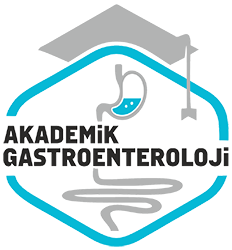Aralik 2022
Insülin direncinin akut pankreatit şiddetine etkisi
Insülin direncinin akut pankreatit siddetine etkisi
- Ana Sayfa
- Sayılar
- Aralik 2022
- Insülin direncinin akut pankreatit şiddetine etkisi...
Sivas Cumhuriyet Üniversitesi Tip Fakültesi, 2Gastroenteroloji Bilim Dali, Sivas
Özet
Giriş ve Amaç: Akut pankreatit, pankreasin çesitli nedenlere bagli inflamasyonudur. Tüm dünyada önemli bir morbidite ve mortalite nedenidir. Metabolik sendromun önemli bir komponenti olan insülin direncinin inflamatuvar bir durum olmasi nedeniyle akut pankreatit Hastalarında hastalık şiddetini etkileyebilecegi düsünülmektedir. Çalışmamızda insülin direncinin akut pankreatit şiddeti ile ilişkisini araştırmayı ve diğer prognostik faktörlerle karsilastirmayi amaçladık. Gereç ve Yöntem: Çalışmamızda klinikte akut pankreatit tanısı ile yatarak tedavi almis 84 hasta değerlendirmeye alinmıştır. Çalışmamız prospektif olarak dizayn edilmıştır. Akut pankreatit şiddetini belirlemek için Hastaların laboratuvar ve görüntüleme bulgulari kullanilarak Atlanta Siniflandirmasi, ‘Bedside Index of Severity in Acute Pancreatitis’ skoru, Imrie skoru, Ranson skoru, Balthazar skoru belirlenmıştır. Hastalarda insülin direnci değerlendirilmesi için “Insülin Direncinin Homeostatik Modeli değerlendirmesi” skoru kullanilmıştır. Buna göre insülin direnci olan ve olmayan gruplar arasında hastalık şiddeti açısından fark olup olmadigi arastirilmıştır. Bulgular: Hastaların %45.2’si insülin direnci olan grupta yer aldi. Atlanta siniflandirmasina göre 6 hasta (%7.1) şiddetli akut pankreatit olarak siniflandirildi. 4 hasta prerenal akut böbrek hasari gelismesi ve 2 hasta sepsis ve yoğun bakım gereksinimi olmasi nedeniyle şiddetli akut pankreatit olarak değerlendirildi. hastalık şiddeti açısından yapılan Receiver Operating Characteristic analizinde Balthazar ve “Yatak basi akut pankreatit şiddet indeksi” skorunun Hastaların prognozunu belirlemede güçlü olduklari görüldü (sırasıyla egri altındaki alan; 0.955 ve 0.979). Insülin direnci olan grubun “Yatak basi akut pankreatit şiddet indeksi” ve Balthazar skorlari, insülin direnci olmayan grup ile karsilastirildiginda istatistiksel olarak anlamli farklilik saptandi (sırasıyla p = 0.019 ve p = 0.013). Sonuç: Çalışmamızda insülin direnci olan akut pankreatit Hastalarında “Yatak basi akut pankreatit şiddet indeksi” ve Balthazar skorlarinin yüksek saptanmasi, insülin direnci varliginin akut pankreatitin şiddetli seyretmesi yönünde prognostik bir faktör olarak kullanilabilecegini düsündürmektedir
Abstract
Background and Aims: Acute pancreatitis is inflammation of the pancreas due to various causes. Insulin resistance is an important component of the metabolic syndrome and causes a chronic inflammatory condition, so it may affect disease severity in acute pancreatitis patients. In our study, we aimed to investigate the relationship of insulin resistance with acute pancreatitis severity and to compare it with other prognostic factors. Materials and Methods: In our study, 84 patients hospitalized in the clinic with a diagnosis of acute pancreatitis were evaluated. Our study was designed prospectively. To determine the severity of acute pancreatitis, the Atlanta Classification, Bedside Index of Severity in Acute Pancreatitis score, Imrie score, Ranson score, and Balthazar score were determined using the laboratory and imaging findings of the patients. The ‘Homeostasis Model Assessment of Insulin Resistance’ score was used to evaluate insulin resistance in patients. Accordingly, it was investigated whether there was a difference between the groups with and without insulin resistance in terms of disease severity. Results: 45.2% of the patients were in the group with insulin resistance. According to the Atlanta classification, 6 patients (7.1%) were evaluated as severe acute pancreatitis. 4 patients were evaluated as severe acute pancreatitis because of the development of prerenal acute kidney injury and 2 patients due to sepsis and need for intensive care. In the Receiver Operating Characteristic analysis performed in terms of disease severity, Balthazar and the ‘Bedside Index of Severity in Acute Pancreatitis’ score were found to be strong in determining the prognosis of the patients (Area Under the Curve; 0.955 and 0.979, respectively). When the ‘Bedside Index of Severity in Acute Pancreatitis’ and Balthazar scores of the group with insulin resistance were compared with the group without insulin resistance, a statistically significant difference was found (p = 0.019 and p = 0.013, respectively). Conclusion: The high ‘Bedside Index of Severity in Acute Pancreatitis’ and Balthazar scores in our study in acute pancreatitis patients with insulin resistance suggest that the presence of insulin resistance can be used as a prognostic factor for severe acute pancreatitis



